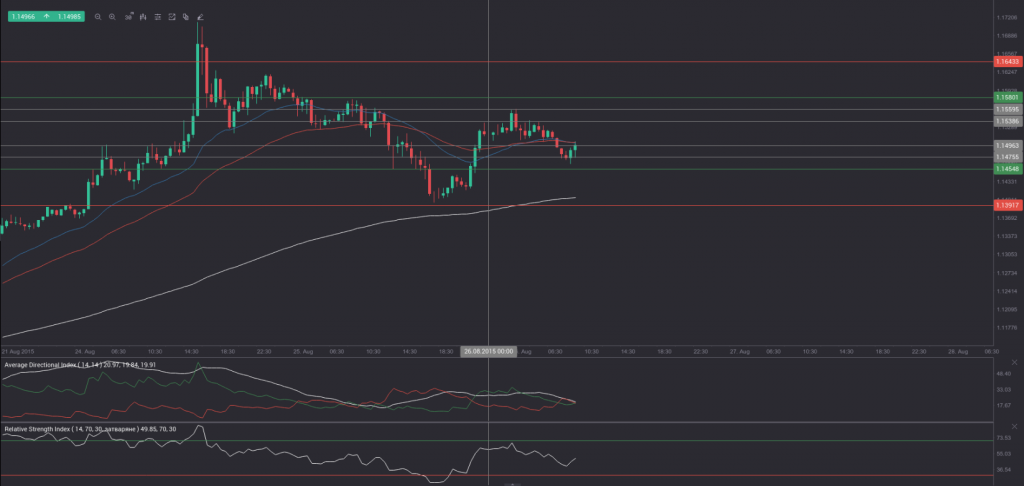Yesterday’s trade saw EUR/USD within the range of 1.1396-1.1625. The pair closed at 1.1517, down 0.89% on a daily basis, or the most considerable daily loss since July 13th, when it depreciated 1.44%. On Monday the cross went up as high as 1.1713, or the highest level since January 15th, when a daily high of 1.1796 was registered.
At 6:41 GMT today EUR/USD was down 0.33% for the day to trade at 1.1481. The pair made an attempt to test the range support level (S3), as it touched a daily low at 1.1465 at 6:09 GMT.
Today the cross may be influenced by a number of macroeconomic reports as listed below.
Fundamentals
United States
Durable Goods Orders
Durable goods orders in the United States probably dropped 0.5% in July compared to a month ago, according to the median forecast by experts. In June new orders for manufactured durable goods rose at a pace of 3.4%, driven by strong bookings for passenger airplanes. It has been the sharpest monthly increase since March, when new orders went up 4.0%.
Transportation equipment rose at a monthly rate of 8.9% to USD 78.4 billion, driven by a 66.1% climb in aircraft orders.
Shipments of manufactured durable goods increased 0.1% to USD 239.4 billion in June, following a 0.3% drop in May. Unfilled orders for manufactured durable goods increased 0.1% to USD 1,195.8 billion in June, after a 0.5% drop in May. Inventories of manufactured durable goods increased 0.4% to USD 402.3 billion in June, reaching the highest level since the series was first published on a NAICS basis in 1992, after a 0.2% decrease in May. Non-defense new orders for capital goods went up 9.4% to reach USD 80.8 billion in June, according to data by the US Census Bureau.
Durable goods orders, as an indicator, gauge the strength of US manufacturing sector and represent a major portion of the nations factory orders. This is a closely watched report on manufacturing activity, because durable goods are the first type of goods to be affected by an economic downturn or upturn.
Durable goods are designed to last three or more years and encompass aircraft, automobiles and buses, cranes, machine parts, appliances etc. More than 85 industries are represented in the sample, which covers the entire United States. The logic behind this indicator is that consumers need to be very optimistic in order to buy an automobile in comparison with, for example, first necessities such as food or clothing. Therefore, durable goods are among the first goods, which a consumer may abstain from purchasing, in case overall economic activity begins to contract. The same is valid for company purchases. During a recession, an airliner is less likely to purchase new aircraft and as factory output contracts, it is less likely to purchase new machines.
Durable goods orders, which exclude transportation, probably rose 0.4% in July compared to June. If so, this would be the fourth consecutive month of expansion. In June orders were up at a revised down 0.6% (+0.8% previously). Large ticket orders, such as automobiles for civil use or aircraft, are not present in the calculation, as their value may be in a wide range. This way the index provides a more reliable information in regard to orders for durable goods.
In case the general index decreased at a faster-than-projected pace, this would have a strong bearish effect on the greenback. The US Census Bureau is scheduled to release the official data at 12:30 GMT.
Bond Yield Spread
The yield on German 2-year government bonds went as high as -0.219% on August 25th, or the highest level since August 3rd (-0.219%), after which it slid to -0.223% at the close to gain 3.4 basis points (0.034 percentage point) on a daily basis.
The yield on US 2-year government bonds climbed as high as 0.645% on August 25th, or the highest level since August 21st (0.662%), after which it fell to 0.609% at the close to gain 2.9 basis points (0.029 percentage point) for the day.
The spread between 2-year US and 2-year German bond yields, which reflects the flow of funds in a short term, shrank to 0.832% on August 25th from 0.837% on August 24th. The August 25th spread has been the lowest one since July 8th, when the difference was 0.806%.
Meanwhile, the yield on German 10-year government bonds soared as high as 0.760% on August 25th, or the highest level since August 5th (0.760%), after which it slid to 0.736% at the close to appreciate 16.0 basis points (0.160 percentage point) compared to August 24th, while marking a second straight day of gains.
The yield on US 10-year government bonds climbed as high as 2.136% on August 25th, or the highest level since August 19th (2.230%), after which it slipped to 2.059% at the close to add 4.7 basis points (0.047 percentage point) on a daily basis. It has been the first gain in the past five trading days.
The spread between 10-year US and 10-year German bond yields narrowed to 1.323% on August 25th from 1.436% during the prior day. The August 25th yield difference has been the lowest one in more than two months.
Daily and Weekly Pivot Levels
By employing the Camarilla calculation method, the daily pivot levels for EUR/USD are presented as follows:
R1 – 1.1538
R2 – 1.1559
R3 (range resistance – green on the 30-minute chart) – 1.1580
R4 (range breakout – red on the 30-minute chart) – 1.1643
S1 – 1.1496
S2 – 1.1475
S3 (range support – green on the 30-minute chart) – 1.1454
S4 (range breakout – red on the 30-minute chart) – 1.1391
By using the traditional method of calculation, the weekly pivot levels for EUR/USD are presented as follows:
Central Pivot Point – 1.1266
R1 – 1.1517
R2 – 1.1645
R3 – 1.1896
S1 – 1.1138
S2 – 1.0887
S3 – 1.0759






